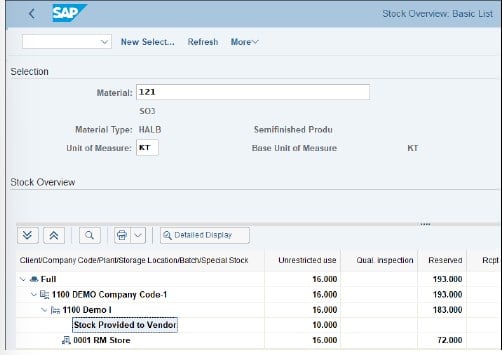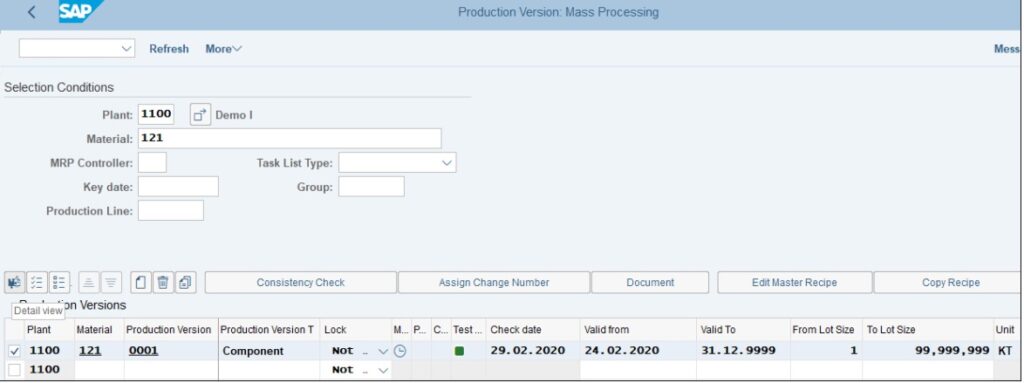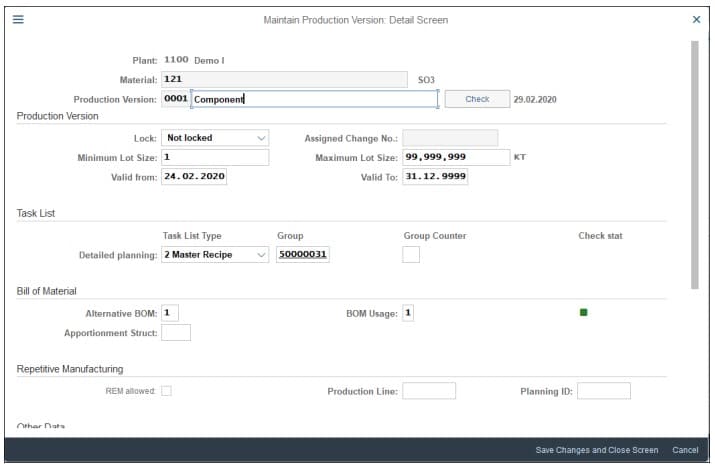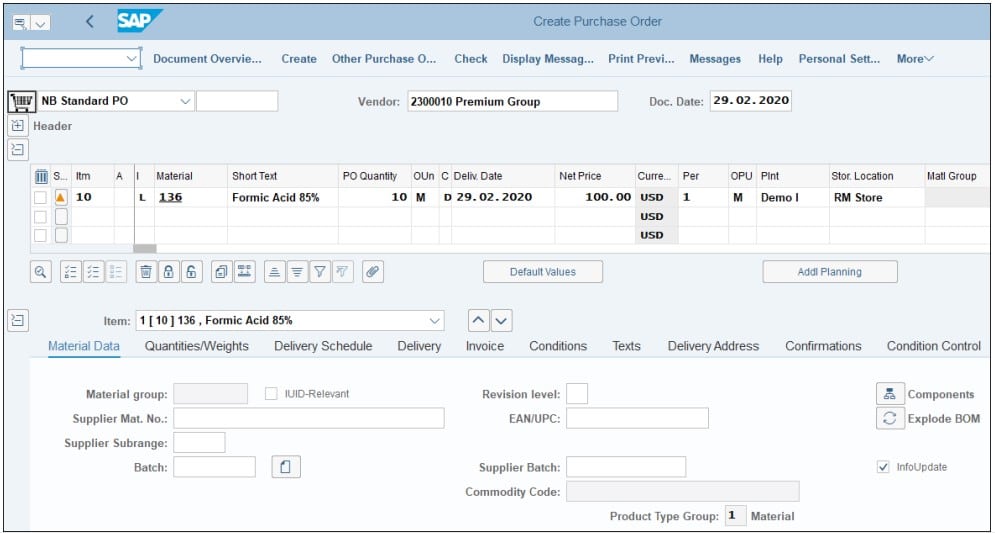SAP has a special way of dealing with the subcontracting in S4/HANA. In a nutshell, you provide components of your manufacturing unit to an outside vendor or subcontractor to add value to the components through further processing or assembling them into a finished product. Subcontracting in SAP S/4HANA is done by issuing a subcontracting purchase order (PO), where the procurement type key is 30 with an item category L. From an inventory view, the subscontracting cockpit, tcode ME2ON, provices you with a view to look at the inventory from the supplying plant to the subcontracting vendor.
This article will look at the subcontracting process in SAP S/4HANA and walk you through the subcontracting process step by step.

Table of Contents
What Are the Prerequisites of Subcontracting?
Before you issue a subcontracting order, there are a few prerequisites to complete. Those are:
- You must assign 30 as the value special procurement type key for the material master of the assembly.
- Ensure that there is a subcontracting bill of materials (BOM) in the system.
- Purchasing view should be present.
- A purchasing info record will reflect the supply source between the material and the vendor. When you create the info record, indicate subcontracting on the initial screen.
- A production version should exist in SAP S/4HANA.
Now, before moving on to the step-by-step subcontracting workflow, let’s quickly go through the classifications of subcontracting on SAP S/4HANA.
What Are The Stages of a Subcontracting in SAP S/4HANA?
There are three primary stages of subcontracting, which are – Purchasing, Inventory Management, and Invoice Verification. All the individual activities within the subcontracting process belong to one of those stages.
Purchasing
Once you decide to issue a subcontracting order for an end product, you will issue a purchase order (PO) by specifying your requirement for the end product. You will then send the raw materials to the vendor for further processing and value addition. There are three ways to arrange the purchasing for subcontracting.
- Purchase Requisition: You can allow SAP S/4HANA to copy the material requirement planning (MRP) specifications through a purchase requisition or bill of material (BOM).
- Purchase Order: You can specify the component items in a PO that you can replicate from the requisition, input manually, or copy from BOM.
- Scheduling Agreement: You can also create a scheduling agreement to set a contract with the supplier to procure and supply a specific quantity of an item at an agreed time.
You will need to indicate document category L as the purchasing master data.
Inventory Management
When you issue a subcontracting order, your company will discard the inventory of the handed-over components out of its records. At the same time, the vendor or subcontractor will record the inventories as its own. The individual functions of inventory management are:
- Provision of components
- Goods receipt
- Adjustment for under or over consumption
- Transfer postings.
The transfer movement types are 301, 309, and 321/322.
Invoice Verification
Once the vendor completes the required or intended task, it sends back the assembled items to your company under the same PO. Your company then authorizes payment for the procured subcontracting items and sends it to the vendor.
You can verify the subcontracting invoice in the same way you validate any typical PO. However, if there is a price variance from over or under consumption, you must do additional account postings. Specifically, there are three such situations for you to adjust the account posting –
- Moving average price control
- Standard Price Control With Price Differences
- Standard Price Control Without Price Differences
Now that we are familiar with the subcontracting components, functions, and activities, let’s walk you through the subcontracting process in SAP S/4HANA.
How to Do Subcontracting in SAP S/4HANA?
You can typically follow the below steps to configure and create a subcontract on SAP S/4HANA.
Configuring a Subcontract
Step 1: You will need to configure the material master view. With transaction MM02 or the following menu path:
Logistics > Production > Master Data > Material Master > Material > Change > Immediately.Step 2: You will get the following screen from MRP 2 tab.

From here you need to select Subcontracting (30).
Creating a Subcontract
After configuring the material master view, you can follow the below steps to create a subcontract.
Step 1: To create a subcontract PO, you can use the transaction code as ME21N. Alternatively, you can follow this menu path:
Logistics > Materials Management > Purchasing > Purchase Order > CreateStep 2: You can input the material purchasing instruction for the subcontract.

To indicate subcontracting, you can then input the item category as L on the third column.

Step 3: Once you click the components icon, the following screen will then allow you to input value for specific subcontract components. You can also copy the values from a previously created BOM.
Step 4: After issuing the subcontract order, you can use code ME2O to monitor stock updates received from the vendor. The record will indicate it as stock provided to the vendor. You also can provide “unrestricted” stock to the vendor.
Step 5: The final step is to post good receipts for the end product received by your business, which you can adjust depending on the actual consumed amount by the vendor.
Subcontracting in Production Version
SAP S/4HANA has made it mandatory to create production versions while issuing a subcontract order. There is a new report available intended for this function – CS_BOM_PRODVER_MIGRATION. Use transaction SE38 to initiate the report.
Once you click Execute, you will get the radio button to indicate “Run in Simulation Mode” to simulate the new production version creation. Once you are satisfied with the simulation testing, you can run the actual operation by clicking “Run in Actual Mode.”
The above procedure is for creating individual production versions. However, what if you want to create production versions of subcontracting for mass processing? Now we will explore that as well with an actual example.
Subcontracting in Production Version: Mass Processing
You will use C223 as transaction code for mass processing the production version and creating new ones, and updating existing ones. While initiating mass processing, you can also lock a production version for automated processing only.
The following screen will appear through the C223 code.

To enter mode details, you need to click “Detail View” after indicating the production version. The following screen will let you edit and input individual details.

To validate if the information is complete and correct, click the “check” function. You will get a traffic light indicator signaling validation for each entry – red indicating an error, yellow indicating a warning, and green indicating complete.
Business Processes in Subcontracting
To initiate a business process in subcontracting, again use ME21N as the transaction code. Next, you will assign a vendor and indicate the item category as L in the first column to make it a subcontracting order.

Afterward, you will get the component overview screen to enter component codes.

After completing the component overview, transaction code ME2O will lead you to the Post Goods Issue window.

Finally, you will have to indicate movement types for the subcontracting order. Movement Type 101 denotes the received assembly materials, whereas Movement Type 543 O assigns the actual consumption of components by the vendor.

While issuing a subcontracting order in SAP S/4HANA, carefully set all the relevant details and categories. Otherwise, your bookkeeping will be complicated. To get expert assistance while configuring your first subcontracting, reach out to SpendWizard, which can connect you with SAP Consultants and implementation partners with several years of industry expertise and relevant certification.
Summary
Subcontracting in SAP S/4HANA often helps you with procurement to save cost and use an external vendor for production assembling to scale your production. You may check SAP’s training center to get more resources and relevant training on SAP S/4HANA procurement and subcontracting.
- Overview of the Material Master in SAP S/4HANA - January 2, 2024
- SAP FICO TRANSACTION CODES (MOST COMMON) - December 24, 2023
- Best SAP S/4HANA MM Books for Beginners and Advanced Learners - November 25, 2023





0 Comments